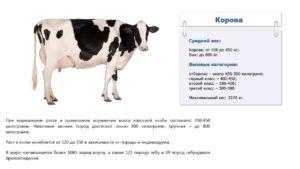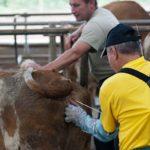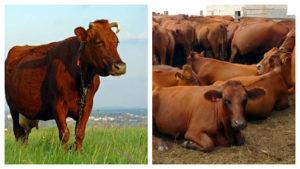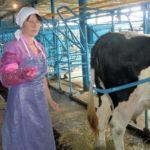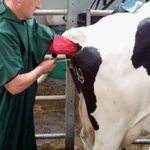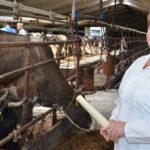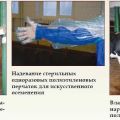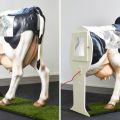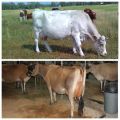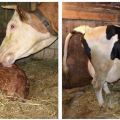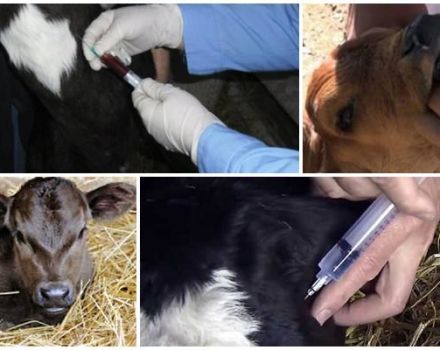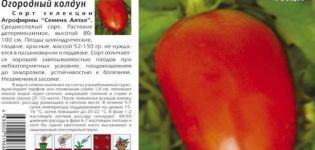Description of the visocervical method of insemination of cows, instruments and scheme
Free mating in large farms is rarely used, since it is laborious and takes a long time. Artificial insemination is the fertilization of a cow, in which the producer bull does not participate, but his sperm is used. It is not easy to inseminate cows visocervically, it must be done by a veterinarian with extensive experience, the procedure requires careful preparation.
When is it required?
On farms that practice artificial insemination, males and females are not mated. The sperm is taken from the breeding bull, frozen, so that it can then be inserted into the cow's vagina using special instruments.
When it is necessary to artificially inseminate a cow:
- To increase the livestock. Natural fertilization takes longer and does not always result in a cow's pregnancy.
- To obtain offspring from a bull with the necessary breed and physical qualities. Sperm from a purebred individual is divided into several portions for insemination of a larger number of females.
- To obtain offspring from a thoroughbred bull, located far from the cow selected for insemination. Sperm is frozen, transported without loss of quality at any distance.
- To obtain calves from an elderly bull, which itself can no longer mount on a cow.
- To reduce the likelihood of the spread of genital infection. Sperm taken from a bull must be examined in the laboratory for the presence of pathogenic microorganisms.
Insemination begins when the cow begins to hunt, which is manifested by restless behavior, swelling and redness of the external genital organs, and secretion of cervical mucus.
Pros and cons
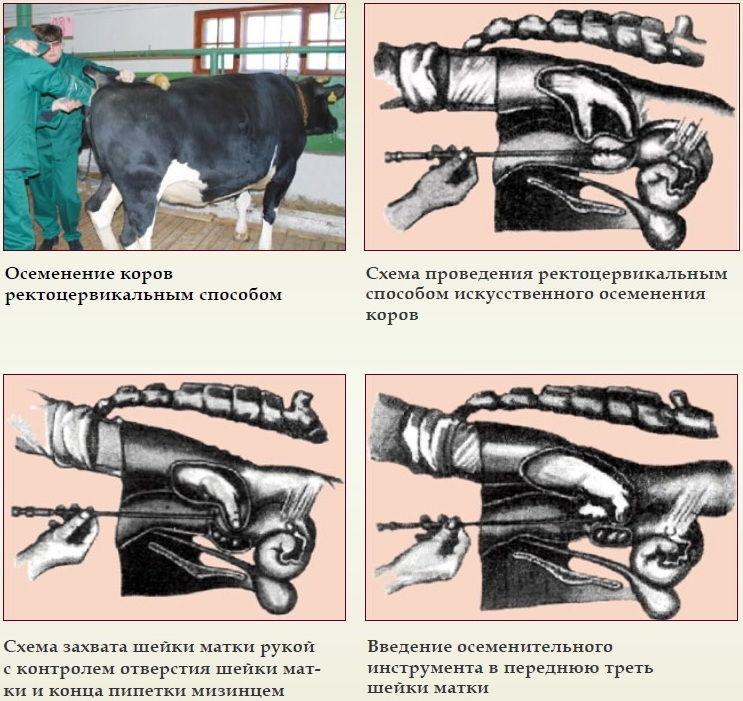
Artificial insemination methods
When developing methods for inseminating livestock, the functional and structural features of the cow's reproductive organs were taken into account:
- Vaginal cow fertilization. The cervix, contracting, draws in sperm into itself, accumulates it, then gives it in portions to the uterus. Therefore, semen is injected into the vaginal area close to the vaginal part of the cervix. A serving must contain at least 10 million active sperm.
- With natural mating, the bull introduces a large amount of sperm into the cow's vagina, with artificial insemination, the percentage of male cells is much lower. Only 5% of sperm survive, accumulate in the cervix. Therefore, in artificial insemination, a full portion of sperm is injected directly into the cervix.
- In a cow that has given birth, the vaginal walls are stretched, and pockets are formed in them. Therefore, the specialist must know exactly the location of the cervix.
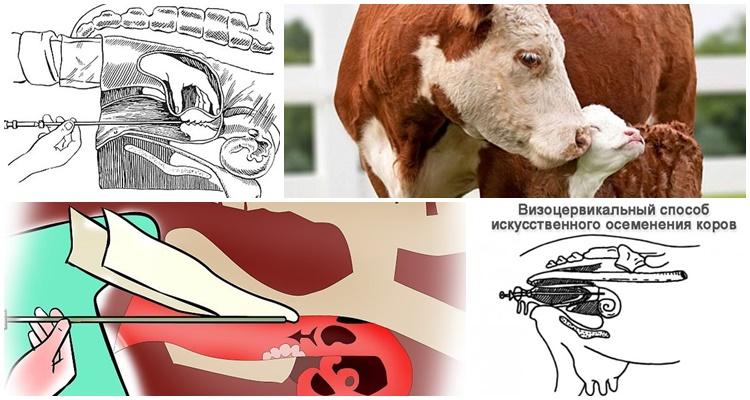
Taking into account these nuances, 4 methods of cow fertilization are used.
Manocervical technique
Translated from the Greek "mano" - hand, and "cervix" - the cervix. That is, this is insemination, in which the location of the cervix is controlled by a hand inserted into the vagina. The method is used to fertilize females who have given birth. The technique is not suitable for inseminating a cow with a narrow vaginal opening. The probability of successful fertilization is 65-70%.
Visocervical
Convenient insemination technique, when the cervical canal, along which the catheter is advanced to the cervix, is viewed using a speculum. From the Greek "viso" - to look. The probability of fertilization with the visocervical method is 50-60%.
Rectocervical
From the Greek "rect" is translated as "rectum". That is, the insemination method involves controlling the position of the cervix by probing through the intestines. It is good because it allows you to introduce semen into the cervix with maximum accuracy, and then immediately massage the reproductive organs of the cow.

A specialist is required to be highly qualified and experienced in performing the procedure, since the risk of injury to the cervix with careless immersion of the catheter is higher than with the visocervical method. The probability of fertilization is over 70%.
Epicervical
From the Greek "epi" is translated as "about". This implies the introduction of semen as close to the cervix as possible. That is, natural fertilization is simulated, in which the sperm leaves the bull's genitals close to the vaginal part of the cervix.
The length of the catheter is almost equal to the distance from the vaginal opening to the cervix. The clitoris is massaged to stimulate the contraction of the semen suction neck. The probability of conception is 60-70%.
What tools are needed?
For insemination by the visocervical method, a catheter for introducing semen and a speculum for viewing the vaginal canal are required. The advantage of visocervical fertilization is good visibility of where to lead the catheter, thereby reducing the likelihood of injury to the vaginal walls.
The instruments used are disinfected before the procedure. For disinfection, prepare 4 containers with lids and a glass jar with thick walls, into which the used solutions will be poured. The containers are signed, filled with the following preparations:
- No. 1, 3, 4 - 1% sodium chloride;
- No. 2 - 70% alcohol.
Solutions are prepared immediately before use.
The inseminator, going to the pets, wears:
- medical cap;
- medical gown;
- oilcloth apron;
- rubber boots;
- medical disposable mask.

Clothes should be washed and ironed, shoes should be clean.
Preparation for the process
Preparation for insemination by the visocervical method consists of several stages:
- The catheter is washed 3 times in solutions No. 1, 3, 4. Placed on sterile tissue.
- The used liquid is poured into a jar.
- The mirror and scissors are sterilized with alcohol # 2. The mirror is also fired over an open flame.
- The container with semen is depressurized with scissors. The contents are filled into the catheter.
- Press on the catheter piston, squeezing out air.
- The catheter is placed on the table with the cannula facing up.
- Wearing gloves for insemination, treat them with alcohol No. 2.
- Before starting the procedure, wash the mirror again with solution No. 1. It shouldn't be cold.
The cow is also prepared for visocervical insemination, immobilized in the machine, the external genitals are washed with warm water, treated with a solution of the drug "Furacilin", and thoroughly wiped.
Scheme of the
Visocervical insemination of a cow is carried out as follows:
- Pull the labia apart. A mirror is immersed in the vagina so that the arms diverge horizontally. The inserted tool is turned over so that the handles diverge vertically, open.
- Find the cervix. A catheter is inserted into it to a depth of about 5 cm. The mirror is slightly shifted towards itself. Slowly pressing on the piston, semen is injected.
- Take out the catheter. The mirror is turned over horizontally, not closed completely so as not to pinch the mucous tissues of the vagina, gently pull out.
- The catheter is washed in liquid No. 1, then in alcohol No. 2. The inside of the catheter is filled with alcohol, so it is sent to a storage location.
- The mirror is washed in a 3% warm solution of sodium bicarbonate, then in boiled water. Fired over an open flame.
In case of visocervical insemination of several cows at once, after each sperm injection, the catheter head is disinfected with a cotton swab moistened with 90% alcohol.
Features of keeping cows after insemination
After visocervical insemination, it is important to keep the cow's genitals clean. Inseminated females are kept separate from the rest of the herd, not stressed. The stall must be clean and dry.
Feed the cow with regular food, but the portion should be larger than usual. After 2 weeks, the animal is reunited with the herd.
Signs of successful insemination
You can understand whether a cow has become pregnant after 10 days. A pregnant female drives a bull away from herself. If, 25 days after the visocervical insemination, estrus has not occurred, then after 9 months offspring can be expected. 20 days after the visocervical procedure, the cow's pregnancy can be confirmed by laboratory means. The pet's blood is taken for analysis of the concentration of progesterone. The onset of pregnancy is signaled by an increased level of the hormone.
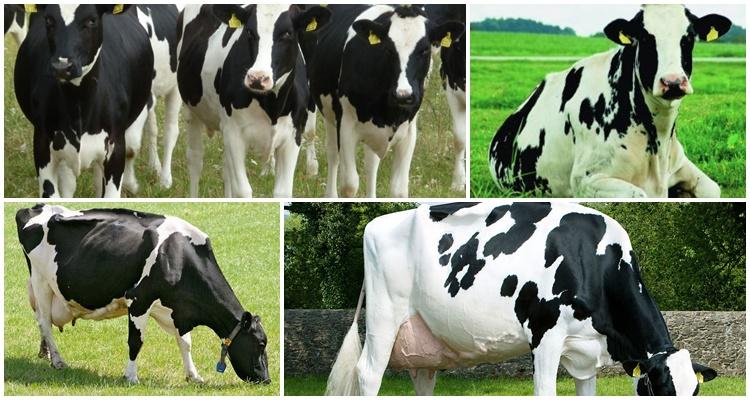
A cow that has not become pregnant after 4 inseminations is sent to slaughter, since her reproductive system is not functioning.
Possible errors and difficulties
Inexperienced inseminators should remember what mistakes should not be made in the process of visocervical insemination:
- Ignore hygiene rules. Work in dirty clothes and shoes.
- Carry out the procedure outside a specially equipped room, without observing sterility.
- Use unsterilized instruments.
- Touch the catheter with your fingers (veterinary glove lubricant destroys sperm).
- Store sperm without freezing. Or periodically defrost it (this reduces the viability of sperm).
- Inserting the catheter inaccurately, pointing it upwards at 30 ° (so you can burrow into the urethra).
- Insert the catheter too deeply (this can injure the wall of the uterus).
- Inject semen into the vaginal pockets instead of the cervix (the inseminator must have a good knowledge of the anatomy of the reproductive organs of cattle).
Visocervical insemination of a cow is not an easy procedure that requires knowledge and skills; the farmer does not have to carry it out on his own. Artificial insemination should be carried out by a veterinarian in equipped insemination points.
